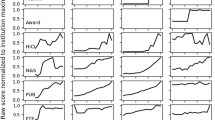Abstract
Although universities’ world rankings are popular, their design and methods still request considerable elaborations. The paper demonstrates some shortcomings in the Academic World Ranking of Universities (ARWU, Shanghai Jiao Tong University) ranking methods. One deficiency is that universities’ scale differences are neglected due to omitting the whole input side. By resampling and reanalyzing the ARWU data, the paper proposes an input-output analysis for measuring universities’ scientific productivity with special emphasis on those universities which meet the productivity threshold (i.e. share of output exceeds share of input) in a certain group of universities. The productivity analysis on Scandinavian universities evaluates multidisciplinary and specialized universities on their own terms; consequently the ranking based on scientific productivity deviates significantly from the ARWU.
Similar content being viewed by others
References
Altbach, P. (2006), The dilemmas of ranking, International Higher Education, 42: 2–3.
Clarke, M. (2005), Quality assessment lessons from Australia and New Zealand, Higher Education in Europe, 30(2): 183–197.
Goodall, A. (2006), The leaders of the world’s top 100 universities, International Higher Education, 42: 3–4.
Jobbins, D. (2005), Moving to a global stage: A media view, Higher Education in Europe, 30(2): 137–145.
Kivinen, O., Hedman, J. (2005A), Yliopistolaitoksen tuloksellisuus Suomessa 1999–2003. Yliopistojen panokset ja tulokset tieteenaloittaisessa tarkastelussa. [Productivity of Finnish Universities. Inputs and outputs compared by disciplines] University of Turku. Research Unit for the Sociology of Education (RUSE). Research report 64. 2004. Turku.
Kivinen, O., Hedman, J. (2005B), “Tieteellisen toiminnan tuloksellisuus. Tieteenaloittainen analyysi.” [“Scientific productivity by disciplines.”], Tieteessä tapahtuu, 23(2): 26–32.
Liu, N. C., Cheng Y. (2005), The academic ranking of world universities, Higher Education in Europe, 30(2): 127–136.
Liu, N. C., Cheng, Y., Liu, L. (2005), Academic ranking of world universities using scientometrics-A comment to the “Fatal Attraction”, Scientometrics, 64(1): 101–109.
Merisotis, J., Sadlak J. (2005), Higher education rankings: Evolution, acceptance, and dialogue, Higher Education in Europe, 30(2): 97–101.
van Raan, A. F. J. (2005A), Fatal attraction: Conceptual and methodological problems in the ranking of universities by bibliometric methods, Scientometrics, 62(1): 133–143.
van Raan, A. F. J. (2005B), Reply to the comments of Liu et al., Scientometrics, 64(1): 111–112.
Author information
Authors and Affiliations
Corresponding author
Rights and permissions
About this article
Cite this article
Kivinen, O., Hedman, J. World-wide university rankings: A Scandinavian approach. Scientometrics 74, 391–408 (2008). https://doi.org/10.1007/s11192-007-1820-y
Received:
Published:
Issue Date:
DOI: https://doi.org/10.1007/s11192-007-1820-y




